Seat Altea XL 2011 Owner's Manual
Manufacturer: SEAT, Model Year: 2011, Model line: Altea XL, Model: Seat Altea XL 2011Pages: 319, PDF Size: 8.92 MB
Page 181 of 319
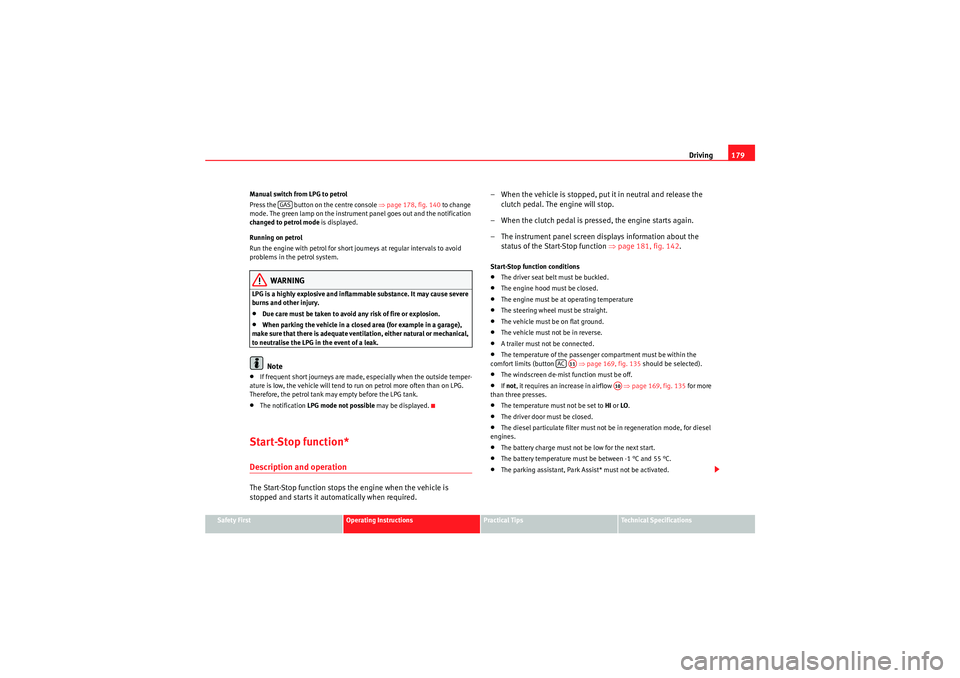
Driving179
Safety First
Operating Instructions
Practical Tips
Technical Specifications
Manual switch from LPG to petrol
Press the button on the centre console
⇒page 178, fig. 140 to change
mode. The green lamp on the instrument panel goes out and the notification
changed to petrol mode is displayed.
Running on petrol
Run the engine with petrol for short journeys at regular intervals to avoid
problems in the petrol system.
WARNING
LPG is a highly explosive and inflammable substance. It may cause severe
burns and other injury.•Due care must be taken to avoid any risk of fire or explosion.•When parking the vehicle in a closed area (for example in a garage),
make sure that there is adequate ventilation, either natural or mechanical,
to neutralise the LPG in the event of a leak.Note
•If frequent short journeys are made, especially when the outside temper-
ature is low, the vehicle will tend to run on petrol more often than on LPG.
Therefore, the petrol tank may empty before the LPG tank.•The notification LPG mode not possible may be displayed.Start-Stop function*Description and operationThe Start-Stop function stops the engine when the vehicle is
stopped and starts it automatically when required. – When the vehicle is stopped, put it in neutral and release the
clutch pedal. The engine will stop.
– When the clutch pedal is pressed, the engine starts again.
– The instrument panel screen displays information about the status of the Start-Stop function ⇒page 181, fig. 142 .
Start-Stop function conditions•The driver seat belt must be buckled.•The engine hood must be closed.•The engine must be at operating temperature•The steering wheel must be straight.•The vehicle must be on flat ground.•The vehicle must not be in reverse.•A trailer must not be connected.•The temperature of the passenger compartment must be within the
comfort limits (button ⇒page 169, fig. 135 should be selected).•The windscreen de-mist function must be off.•If not , it requires an increase in airflow ⇒page 169, fig. 135 for more
than three presses.•The temperature must not be set to HI or LO .•The driver door must be closed.•The diesel particulate filter must not be in regeneration mode, for diesel
engines.•The battery charge must not be low for the next start.•The battery temperature must be between -1 °C and 55 °C.•The parking assistant, Park Assist* must not be activated.
GAS
ACA11
A10
AlteaXL_EN.book Seite 179 Donnerstag, 9. September 2010 12:13 12
Page 182 of 319
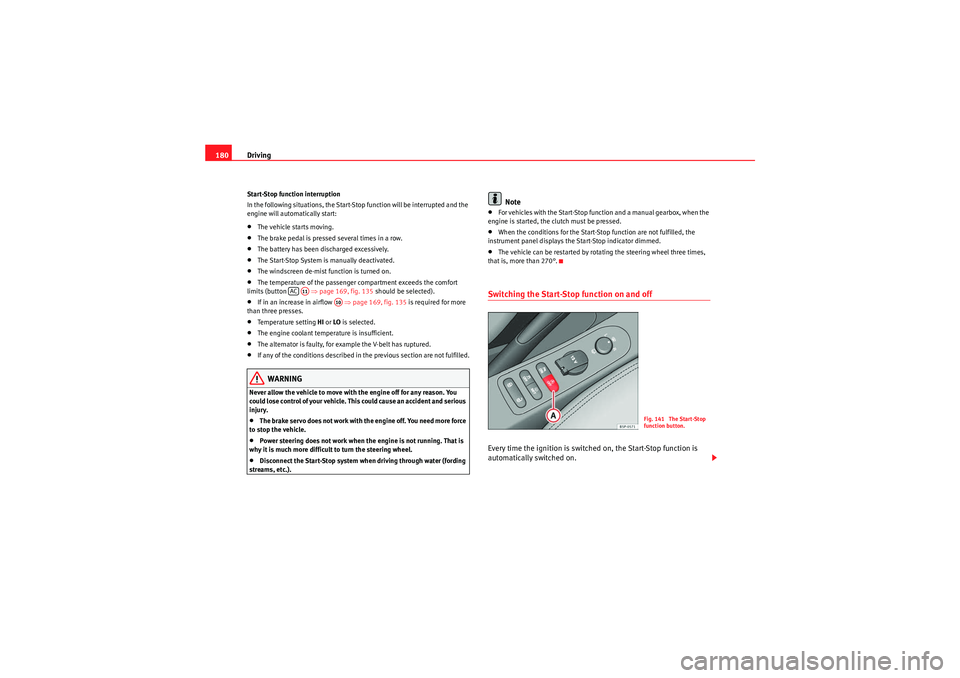
Driving
180Start-Stop function interruption
In the following situations, the Start-Stop function will be interrupted and the
engine will automatically start:•The vehicle starts moving.•The brake pedal is pressed several times in a row.•The battery has been discharged excessively.•The Start-Stop System is manually deactivated.•The windscreen de-mist function is turned on.•The temperature of the passenger compartment exceeds the comfort
limits (button ⇒page 169, fig. 135 should be selected).•If in an increase in airflow ⇒page 169, fig. 135 is required for more
than three presses.•Temperature setting HI or LO is selected.•The engine coolant temperature is insufficient.•The alternator is faulty, for example the V-belt has ruptured.•If any of the conditions described in the previous section are not fulfilled.WARNING
Never allow the vehicle to move with the engine off for any reason. You
could lose control of your vehicle. This could cause an accident and serious
injury.•The brake ser vo does not work with the engine off. You need more force
to stop the vehicle.•Power steering does not work when the engine is not running. That is
why it is much more difficult to turn the steering wheel.•Disconnect the Start-Stop system when driving through water (fording
streams, etc.).
Note
•For vehicles with the Star t-Stop function and a manual gearbox, when the
engine is started, the clutch must be pressed.•When the conditions for the Start-Stop function are not fulfilled, the
instrument panel displays the Start-Stop indicator dimmed.•The vehicle can be restarted by rotating the steering wheel three times,
that is, more than 270°.Switching the Start-Stop function on and offEvery time the ignition is switched on, the Start-Stop function is
automatically switched on.
ACA11
A10
Fig. 141 The Start-Stop
function button.
AlteaXL_EN.book Seite 180 Donnerstag, 9. September 2010 12:13 12
Page 183 of 319
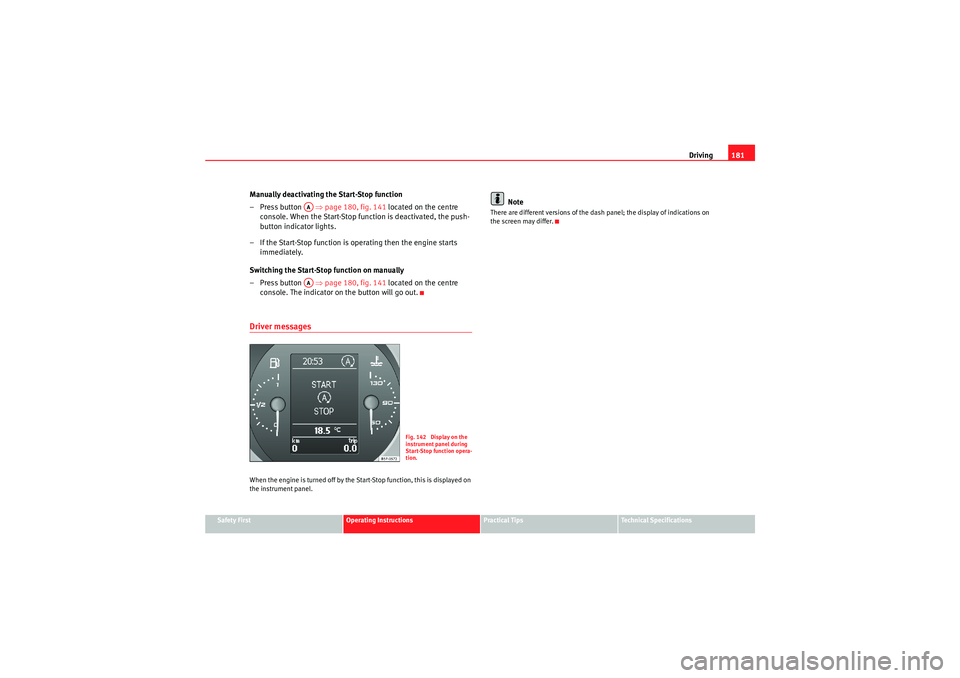
Driving181
Safety First
Operating Instructions
Practical Tips
Technical Specifications
Manually deactivating the Start-Stop function
– Press button ⇒page 180, fig. 141 located on the centre
console. When the Start-Stop function is deactivated, the push-
button indicator lights.
– If the Start-Stop function is operating then the engine starts immediately.
Switching the Start-Stop function on manually
– Press button ⇒page 180, fig. 141 located on the centre
console. The indicator on the button will go out.Driver messagesWhen the engine is turned off by the Start-Stop function, this is displayed on
the instrument panel.
Note
There are different versions of the dash panel; the display of indications on
the screen may differ.
AAAA
Fig. 142 Display on the
instrument panel during
Start-Stop function opera-
tion.
AlteaXL_EN.book Seite 181 Donnerstag, 9. September 2010 12:13 12
Page 184 of 319
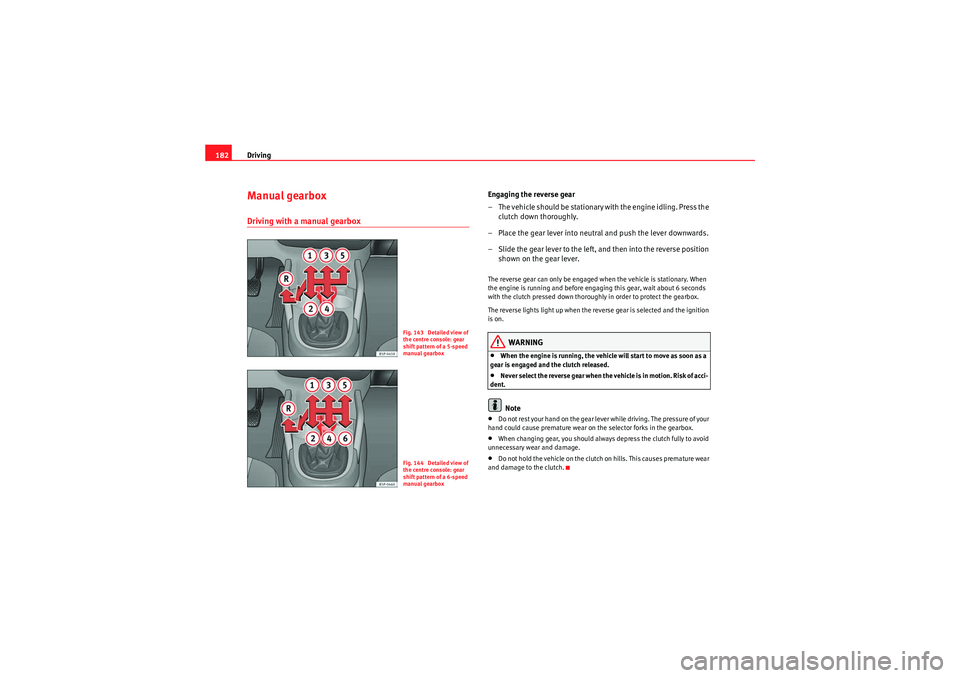
Driving
182Manual gearboxDriving with a manual gearbox
Engaging the reverse gear
– The vehicle should be stationary with the engine idling. Press the
clutch down thoroughly.
– Place the gear lever into neutral and push the lever downwards.
– Slide the gear lever to the left, and then into the reverse position shown on the gear lever.The reverse gear can only be engaged when the vehicle is stationary. When
the engine is running and before engaging this gear, wait about 6 seconds
with the clutch pressed down thoroughly in order to protect the gearbox.
The reverse lights light up when the reverse gear is selected and the ignition
is on.
WARNING
•When the engine is running, the vehicl e will start to move as soon as a
gear is engaged and the clutch released.•Never select the reverse gear when the vehicle is in motion. Risk of acci-
dent.Note
•Do not rest your hand on the gear lever while driving. The pressure of your
hand could cause premature wear on the selector forks in the gearbox.•When changing gear, you should always depress the clutch fully to avoid
unnecessary wear and damage.•Do not hold the vehicle on the clutch on hills. This causes premature wear
and damage to the clutch.
Fig. 143 Detailed view of
the centre console: gear
shift pattern of a 5-speed
manual gearboxFig. 144 Detailed view of
the centre console: gear
shift pattern of a 6-speed
manual gearbox
AlteaXL_EN.book Seite 182 Donnerstag, 9. September 2010 12:13 12
Page 185 of 319
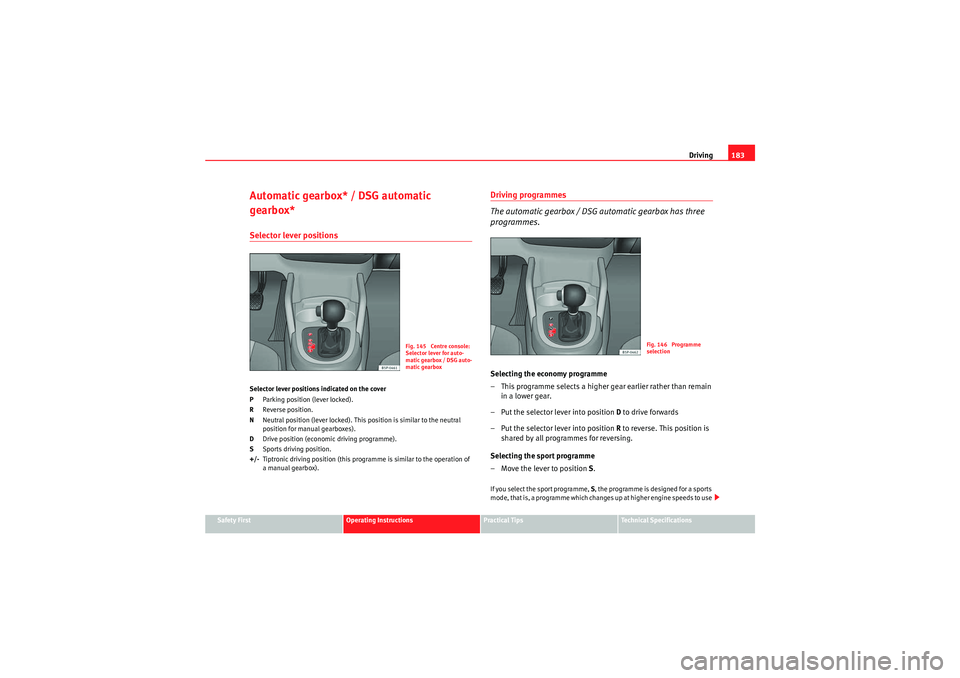
Driving183
Safety First
Operating Instructions
Practical Tips
Technical Specifications
Automatic gearbox* / DSG automatic
gearbox*Selector lever positionsSelector lever positions indicated on the cover
PParking position (lever locked).
R Reverse position.
N Neutral position (lever locked). This position is similar to the neutral
position for manual gearboxes).
D Drive position (economic driving programme).
S Sports driving position.
+/- Tiptronic driving position (this programme is similar to the operation of
a manual gearbox).
Driving programmes
The automatic gearbox / DSG automatic gearbox has three
programmes.Selecting the economy programme
– This programme selects a higher ge ar earlier rather than remain
in a lower gear.
– Put the selector lever into position D to drive forwards
– Put the selector lever into position R to reverse. This position is
shared by all programmes for reversing.
Selecting the sport programme
– Move the lever to position S.If you select the sport programme, S, the programme is designed for a sports
mode, that is, a programme which changes up at higher engine speeds to use
Fig. 145 Centre console:
Selector lever for auto-
matic gearbox / DSG auto-
matic gearbox
Fig. 146 Programme
selection
AlteaXL_EN.book Seite 183 Donnerstag, 9. September 2010 12:13 12
Page 186 of 319
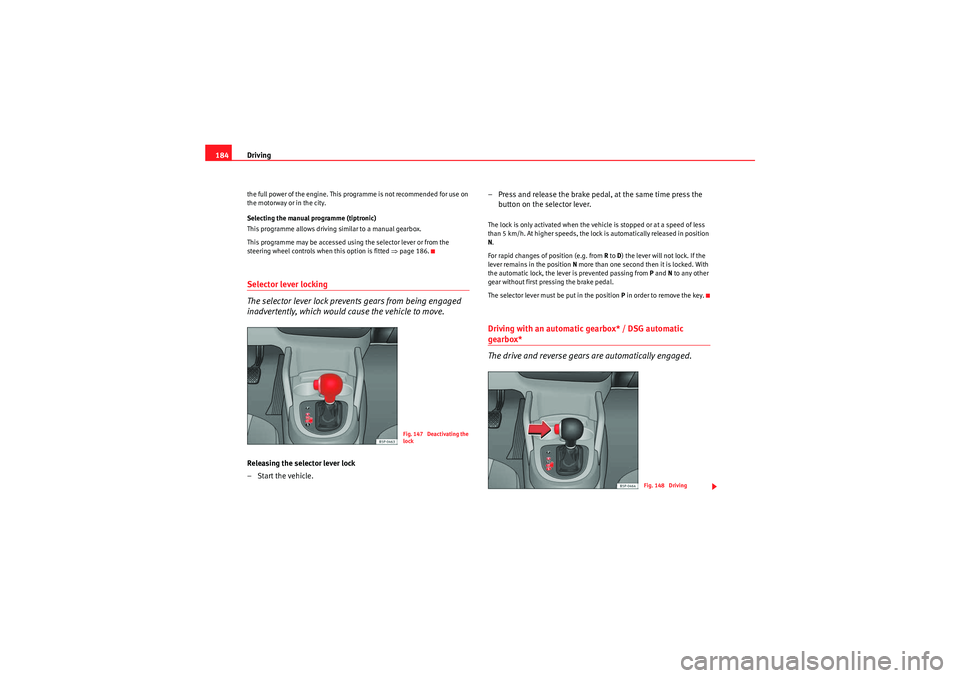
Driving
184the full power of the engine. This programme is not recommended for use on
the motorway or in the city.
Selecting the manual programme (tiptronic)
This programme allows driving similar to a manual gearbox.
This programme may be accessed using the selector lever or from the
steering wheel controls when this option is fitted ⇒page 186.Selector lever locking
The selector lever lock prevents gears from being engaged
inadvertently, which would cause the vehicle to move.Releasing the selector lever lock
–Start the vehicle. – Press and release the brake pedal, at the same time press the
button on the selector lever.
The lock is only activated when the vehicle is stopped or at a speed of less
than 5 km/h. At higher speeds, the lock is automatically released in position
N.
For rapid changes of position (e.g. from R to D) the lever will not lock. If the
lever remains in the position N more than one second then it is locked. With
the automatic lock, the lever is prevented passing from P and N to any other
gear without first pressing the brake pedal.
The selector lever must be put in the position P in order to remove the key.Driving with an automatic gearbox* / DSG automatic gearbox*
The drive and reverse gears are automatically engaged.
Fig. 147 Deactivating the
lock
Fig. 148 Driving
AlteaXL_EN.book Seite 184 Donnerstag, 9. September 2010 12:13 12
Page 187 of 319
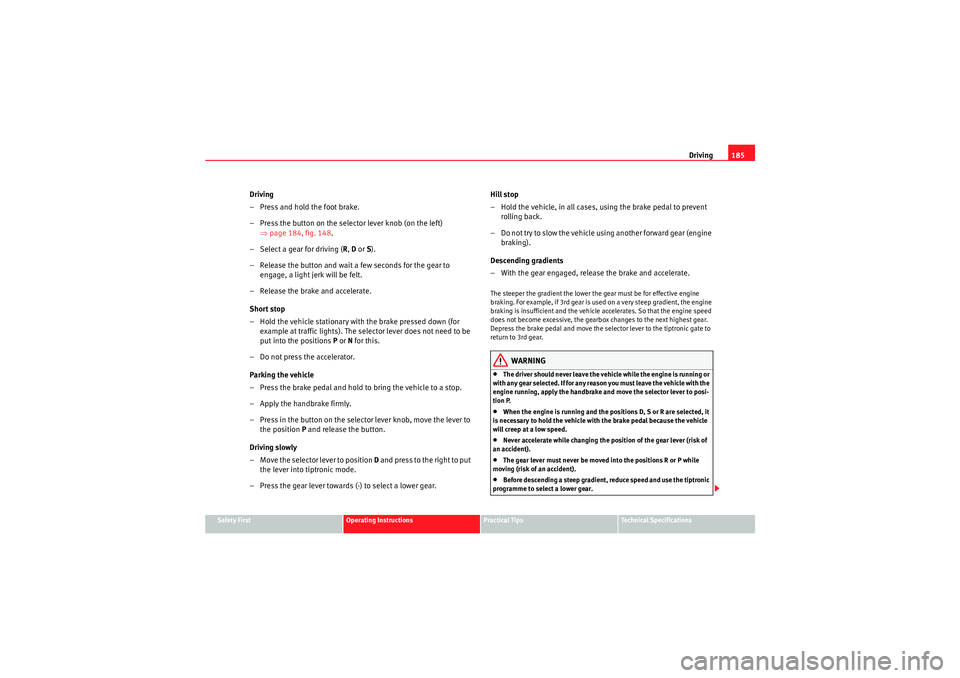
Driving185
Safety First
Operating Instructions
Practical Tips
Technical Specifications
Driving
– Press and hold the foot brake.
– Press the button on the selector lever knob (on the left)
⇒page 184, fig. 148 .
– Select a gear for driving ( R, D or S).
– Release the button and wait a few seconds for the gear to engage, a light jerk will be felt.
– Release the brake and accelerate.
Short stop
– Hold the vehicle stationary with the brake pressed down (for example at traffic lights). The selector lever does not need to be
put into the positions P or N for this.
– Do not press the accelerator.
Parking the vehicle
– Press the brake pedal and hold to bring the vehicle to a stop.
– Apply the handbrake firmly.
– Press in the button on the selector lever knob, move the lever to the position P and release the button.
Driving slowly
– Move the selector lever to position D and press to the right to put
the lever into tiptronic mode.
– Press the gear lever towards (-) to select a lower gear. Hill stop
– Hold the vehicle, in all cases, using the brake pedal to prevent
rolling back.
– Do not try to slow the vehicle using another forward gear (engine braking).
Descending gradients
– With the gear engaged, release the brake and accelerate.
The steeper the gradient the lower the gear must be for effective engine
braking. For example, if 3rd gear is us ed on a very steep gradient, the engine
braking is insufficient and the vehicle accelerates. So that the engine speed
does not become excessive, the gearbox changes to the next highest gear.
Depress the brake pedal and move the selector lever to the tiptronic gate to
return to 3rd gear.
WARNING
•The driver should never leave the vehicle while the engine is running or
with any gear selected. If for any reason you must leave the vehicle with the
engine running, apply the handbrake and move the selector lever to posi-
tion P.•When the engine is running and the positions D, S or R are selected, it
is necessary to hold the vehicle with the brake pedal because the vehicle
will creep at a low speed.•Never accelerate while changing the position of the gear lever (risk of
an accident).•The gear lever must never be moved into the positions R or P while
moving (risk of an accident).•Before descending a steep gradient, reduce speed and use the tiptronic
programme to select a lower gear.
AlteaXL_EN.book Seite 185 Donnerstag, 9. September 2010 12:13 12
Page 188 of 319
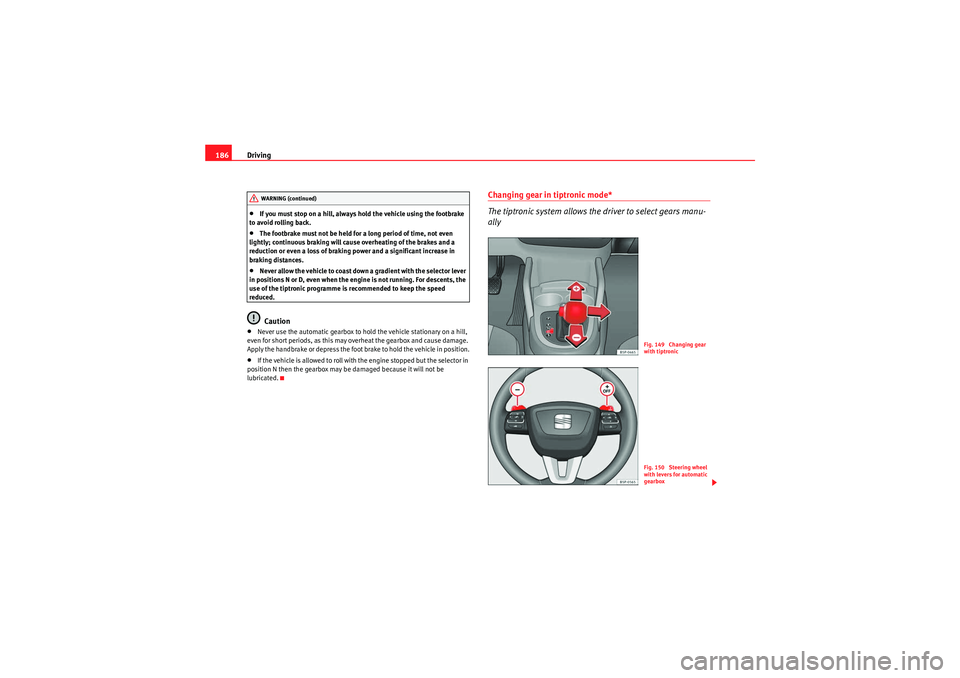
Driving
186•If you must stop on a hill, always hold the vehicle using the footbrake
to avoid rolling back.•The footbrake must not be held for a long period of time, not even
lightly; continuous braking will cause overheating of the brakes and a
reduction or even a loss of braking power and a significant increase in
braking distances.•Never allow the vehicle to coast down a gradient with the selector lever
in positions N or D, even when the engine is not running. For descents, the
use of the tiptronic programme is recommended to keep the speed
reduced.Caution
•Never use the automatic gearbox to hold the vehicle stationary on a hill,
even for short periods, as this may overheat the gearbox and cause damage.
Apply the handbrake or depress the foot brake to hold the vehicle in position.•If the vehicle is allowed to roll with the engine stopped but the selector in
position N then the gearbox may be damaged because it will not be
lubricated.
Changing gear in tiptronic mode*
The tiptronic system allows the driver to select gears manu-
ally
WARNING (continued)
Fig. 149 Changing gear
with tiptronicFig. 150 Steering wheel
with levers for automatic
gearbox
AlteaXL_EN.book Seite 186 Donnerstag, 9. September 2010 12:13 12
Page 189 of 319
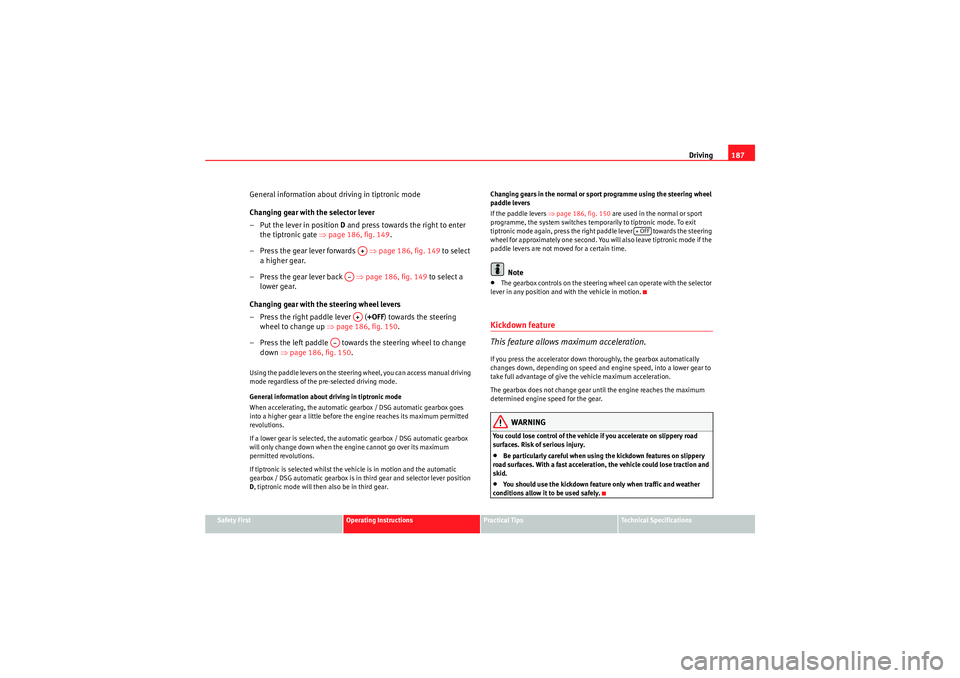
Driving187
Safety First
Operating Instructions
Practical Tips
Technical Specifications
General information about driving in tiptronic mode
Changing gear with the selector lever
–Put the lever in position D and press towards the right to enter
the tiptronic gate ⇒page 186, fig. 149 .
– Press the gear lever forwards ⇒page 186, fig. 149 to select
a higher gear.
– Press the gear lever back ⇒page 186, fig. 149 to select a
lower gear.
Changing gear with the steering wheel levers
– Press the right paddle lever ( +OFF) towards the steering
wheel to change up ⇒ page 186, fig. 150.
– Press the left paddle towards the steering wheel to change
down ⇒page 186, fig. 150 .Using the paddle levers on the steering wheel, you can access manual driving
mode regardless of the pre-selected driving mode.
General information about driving in tiptronic mode
When accelerating, the automatic gearbox / DSG automatic gearbox goes
into a higher gear a little before the engine reaches its maximum permitted
revolutions.
If a lower gear is selected, the automatic gearbox / DSG automatic gearbox
will only change down when the engine cannot go over its maximum
permitted revolutions.
If tiptronic is selected whilst the vehicle is in motion and the automatic
gearbox / DSG automatic gearbox is in third gear and selector lever position
D, tiptronic mode will then also be in third gear. Changing gears in the normal or sport programme using the steering wheel
paddle levers
If the paddle levers ⇒
page 186, fig. 150 are used in the normal or sport
programme, the system switches temporarily to tiptronic mode. To exit
tiptronic mode again, press the right paddle lever towards the steering
wheel for approximately one second. You will also leave tiptronic mode if the
paddle levers are not moved for a certain time.
Note
•The gearbox controls on the steering wheel can operate with the selector
lever in any position and with the vehicle in motion.Kickdown feature
This feature allows maximum acceleration.If you press the accelerator down thoroughly, the gearbox automatically
changes down, depending on speed and e ngine speed, into a lower gear to
take full advantage of give the vehicle maximum acceleration.
The gearbox does not change gear until the engine reaches the maximum
determined engine speed for the gear.
WARNING
You could lose control of the vehicle if you accelerate on slippery road
surfaces. Risk of serious injury.•Be particularly careful when using the kickdown features on slippery
road surfaces. With a fast acceleration, the vehicle could lose traction and
skid.•You should use the kickdown feature only when traffic and weather
conditions allow it to be used safely.
A+
A–A+
A–
+ OFF
AlteaXL_EN.book Seite 187 Donnerstag, 9. September 2010 12:13 12
Page 190 of 319
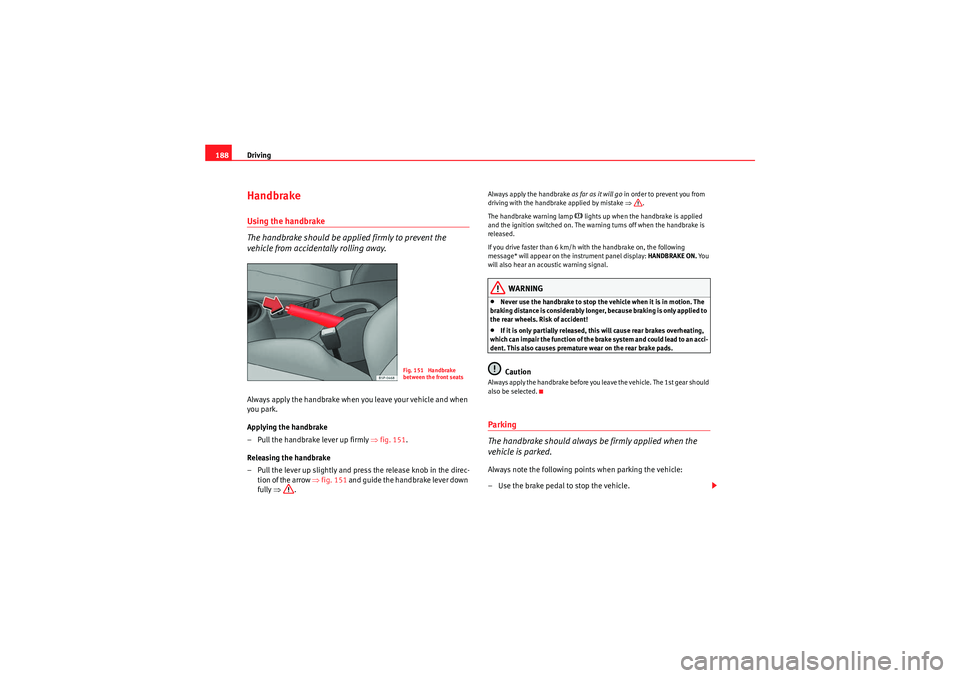
Driving
188HandbrakeUsing the handbrake
The handbrake should be applied firmly to prevent the
vehicle from accidentally rolling away.Always apply the handbrake when you leave your vehicle and when
you park.
Applying the handbrake
– Pull the handbrake lever up firmly ⇒fig. 151 .
Releasing the handbrake
– Pull the lever up slightly and press the release knob in the direc- tion of the arrow ⇒fig. 151 and guide the handbrake lever down
fully ⇒ .
Always apply the handbrake as far as it will go in order to prevent you from
driving with the handbrake applied by mistake ⇒.
The handbrake warning lamp
�H lights up when the handbrake is applied
and the ignition switched on. The warning turns off when the handbrake is
released.
If you drive faster than 6 km/h with the handbrake on, the following
message* will appear on the instrument panel display: HANDBRAKE ON. Yo u
will also hear an acoustic warning signal.
WARNING
•Never use the handbrake to stop the vehicle when it is in motion. The
braking distance is considerably longer, because braking is only applied to
the rear wheels. Risk of accident!•If it is only partially released, this will cause rear brakes overheating,
which can impair the function of the brake system and could lead to an acci-
dent. This also causes premature wear on the rear brake pads.Caution
Always apply the handbrake before you leave the vehicle. The 1st gear should
also be selected.Parking
The handbrake should always be firmly applied when the
vehicle is parked.Always note the following points when parking the vehicle:
– Use the brake pedal to stop the vehicle.
Fig. 151 Handbrake
between the front seats
AlteaXL_EN.book Seite 188 Donnerstag, 9. September 2010 12:13 12